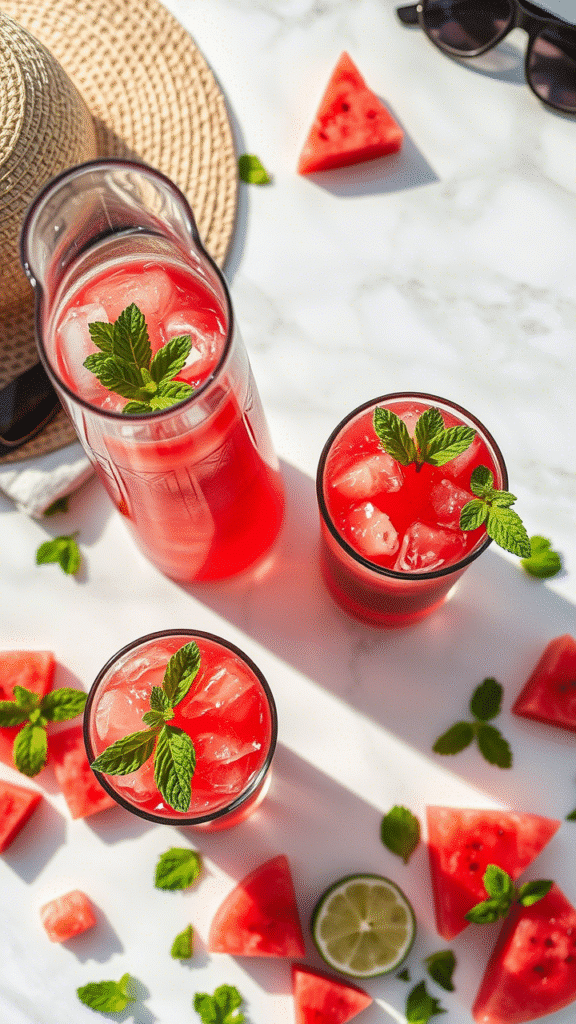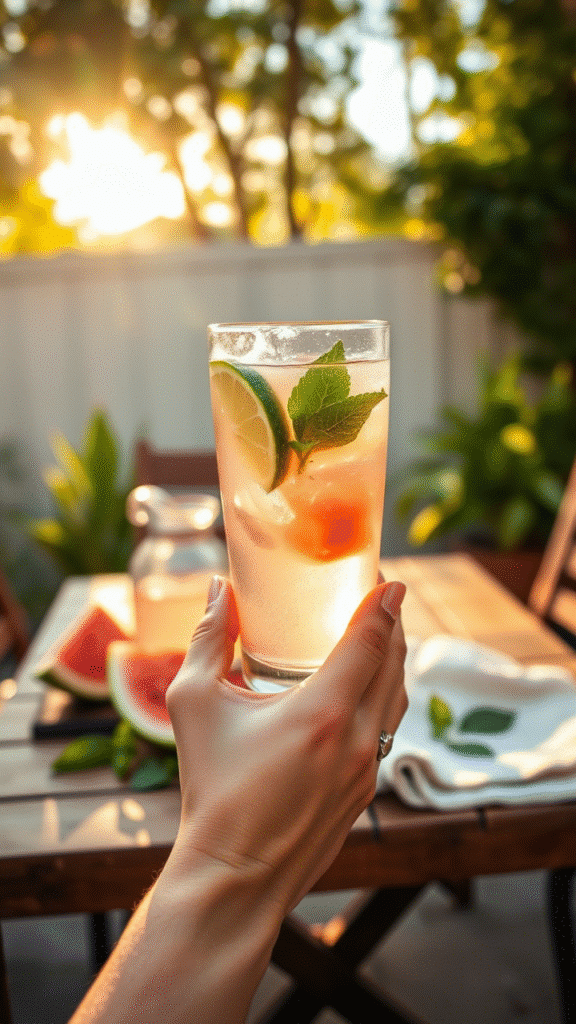Last summer, I watched a street vendor in Guadalajara turn a humble watermelon into liquid gold with nothing more than a blender and some lime juice. The queue of locals stretched around the corner, all waiting for their plastic cup of crimson perfection. That’s when I realized that agua fresca isn’t just a drink it’s pure summer captured in a glass.
Watermelon agua fresca represents the pinnacle of Mexican beverage artistry, transforming simple ingredients into something that’s simultaneously thirst-quenching and soul-satisfying. This isn’t your typical smoothie or juice drink; it’s a delicate balance of fruit, water, and brightness that requires understanding both technique and tradition. The drink’s genius lies in its restraint how it amplifies the natural sweetness of watermelon without overwhelming it.
What makes this particular agua fresca so special is how it celebrates the watermelon’s inherent qualities rather than masking them. Unlike heavy fruit drinks that rely on added sugars or artificial flavors, authentic watermelon agua fresca lets the fruit shine through proper preparation and thoughtful seasoning. The result is a beverage that’s incredibly refreshing yet surprisingly complex in its simplicity.
Ingredients & Substitutions

Primary Ingredients
- 6 cups cubed seedless watermelon (about 3 pounds whole melon)
- 2 cups cold filtered water
- 3 tablespoons fresh lime juice
- 2 tablespoons granulated sugar (optional)
- 1/4 teaspoon fine sea salt
- Fresh mint leaves for garnish
The quality of your watermelon determines everything about this drink. Look for melons that sound hollow when tapped and have a creamy yellow spot where they rested on the ground. The flesh should be deep red with minimal white streaking, which indicates proper ripeness and concentrated flavor. Many home cooks make the mistake of using overripe or underripe fruit, which creates either a mushy texture or bland taste.
Smart Substitutions for Dietary Needs
For those watching sugar intake, the natural sweetness of a perfectly ripe watermelon often eliminates the need for added sugar entirely. Taste your fruit first before deciding. Agave nectar works beautifully as a substitute, using about 1 1/2 tablespoons instead of the granulated sugar. Stevia can work too, but use it sparingly since it’s much more potent maybe 1/4 teaspoon liquid stevia.
If you can’t find fresh limes, bottled lime juice works in a pinch, though you’ll lose some of the bright, floral notes that fresh citrus provides. Meyer lemons offer an interesting twist, creating a slightly sweeter, more complex flavor profile. For the adventurous, try key limes if you can find them their intense tartness creates an almost electric contrast with the sweet watermelon.
The salt might seem unusual, but it’s crucial for enhancing the watermelon’s natural flavors. Kosher salt works fine, but avoid table salt which can taste metallic. Pink Himalayan salt adds a subtle mineral complexity that pairs beautifully with the fruit’s sweetness.
Regional Ingredient Variations
In different parts of Mexico, you’ll find fascinating regional variations. Some areas add a pinch of chili powder or chamoy for heat and complexity. Others incorporate fresh ginger for a spicy kick that complements the cooling watermelon. Tamarind paste creates an interesting sweet-sour dynamic, though this moves the drink into more complex territory.
Step-by-Step Instructions
Preparation Phase
Start by selecting your watermelon carefully this step determines your drink’s success. Cut the melon into manageable chunks, removing seeds if using a seeded variety. Don’t worry about getting every single seed; a few won’t hurt the final product. The key is cutting uniform pieces that will blend easily without overtaxing your equipment.
Chill your watermelon chunks for at least 30 minutes before blending. Cold fruit creates a more refreshing drink and reduces the need for ice, which can dilute the flavors. This simple step separates amateur attempts from professional-quality results.
The Blending Process
Add the watermelon chunks to your blender first, followed by half the water. This order prevents the blender from struggling with too much liquid at once. Blend on high speed for 45-60 seconds until completely smooth. The mixture should be uniformly pink with no visible fruit pieces.
Here’s where technique matters: blend in two batches if necessary rather than overpacking your blender. Overloading creates uneven blending and can burn out your motor. Professional kitchens always prioritize equipment longevity over speed.
Add the remaining water, lime juice, and salt. Pulse gently to combine these shouldn’t be blended aggressively since you don’t want to create too much foam. Taste at this point and adjust sweetness if needed. Remember, the flavors will meld and intensify as the drink sits.
Straining for Perfection
Pass the mixture through a fine-mesh strainer, pressing the pulp gently with the back of a spoon. This step creates the silky texture that distinguishes professional agua fresca from home attempts. Some cooks skip this step, but straining removes any remaining pulp and creates that characteristic smooth mouthfeel.
Don’t press too hard when straining; you want to remove fiber without forcing thick pulp through the mesh. The goal is clarity and smoothness, not maximum yield. What remains in the strainer can be composted or added to smoothies later.
Cooking Techniques & Science
Understanding Watermelon Chemistry
Watermelon consists of roughly 92% water, which makes it perfect for agua fresca but also presents unique challenges. The fruit’s high water content means you’re not just extracting juice you’re creating a structured hydration system that must maintain flavor integrity despite dilution.
The cellular structure of watermelon breaks down easily under mechanical force, which is why gentle blending produces better results than aggressive processing. Over-blending can create a foamy, almost mealy texture that’s unpleasant to drink. Professional techniques focus on achieving complete breakdown with minimal agitation.
The Role of Acid and Salt
Lime juice serves multiple functions beyond flavor enhancement. The citric acid helps preserve the drink’s vibrant color by preventing oxidation, which is why fresh agua fresca maintains its brilliant red hue while stored versions can turn brownish. The acid also brightens the overall flavor profile, making the watermelon taste more intensely like itself.
Salt performs flavor magic that most home cooks don’t understand. At the molecular level, sodium ions enhance our perception of sweetness while suppressing bitter compounds. This is why a tiny amount of salt makes watermelon taste dramatically sweeter and more complex. The effect is subtle but transformative.
Temperature and Texture Dynamics
Serving temperature dramatically affects flavor perception. Agua fresca tastes best when served ice-cold but not frozen. The ideal temperature range is 35-40°F, which enhances the refreshing qualities without numbing the taste buds. Too cold, and you lose flavor complexity; too warm, and the drink feels heavy and cloying.
The texture should be smooth and flowing, similar to thin fruit nectar. If your agua fresca feels thick or syrupy, you’ve either used overripe fruit or insufficient water. The consistency should allow easy drinking without feeling like you’re consuming a smoothie.
Equipment Impact on Results
Blender Selection Matters
High-powered blenders like Vitamix or Blendtec create superior texture by completely breaking down cellular structure. However, regular blenders work fine if you adjust your technique. Lower-powered machines require smaller batches and longer blending times, but they can still produce excellent results.
The blender jar material affects the process too. Glass jars don’t absorb flavors and are easier to clean, while plastic can retain odors from previous uses. For the purest flavor, glass wins every time.
Straining Equipment
A fine-mesh strainer is non-negotiable for professional results. Cheesecloth works but requires multiple layers and careful handling. Some chefs use a chinois (conical strainer) for the smoothest possible texture, though this level of refinement isn’t necessary for home preparation.
Serving & Pairing Suggestions
Presentation Excellence
Serve agua fresca in clear glass vessels to showcase its beautiful color. Traditional Mexican clay cups (jarros) add authentic charm and actually keep the drink cooler longer due to evaporation cooling. The rustic appearance contrasts beautifully with the vibrant red liquid.
Garnish simply with fresh mint sprigs and lime wheels. Over-garnishing distracts from the drink’s pure essence. A single mint sprig provides aromatic enhancement without overwhelming the delicate watermelon flavor. Some bartenders add a thin watermelon wedge to the rim, which looks elegant and reinforces the primary flavor.
Perfect Food Pairings
Watermelon agua fresca pairs magnificently with spicy Mexican cuisine. The cooling effect balances heat from chilies, while the fruit’s sweetness complements smoky grilled meats. Tacos al pastor, with their combination of pork, pineapple, and spice, create a perfect harmony with this drink.
For lighter fare, consider pairing with fresh ceviches or grilled fish. The acidity in both the drink and the seafood creates a refreshing combination that’s perfect for hot weather dining. Agua fresca also works wonderfully with summer salads featuring fruits, nuts, and light vinaigrettes.
Creative Serving Ideas
Transform agua fresca into sophisticated cocktails by adding white rum or silver tequila. The clean spirits don’t compete with the watermelon’s delicate flavor while adding complexity and depth. A splash of prosecco creates an elegant spritzer perfect for brunches or afternoon entertaining.
For non-alcoholic variations, try adding fresh basil instead of mint for an herbal complexity. Cucumber agua fresca mixed with watermelon creates an incredibly refreshing spa-like drink that’s perfect for hot summer afternoons. The combination tastes like liquid summer itself.
Professional Tips and Troubleshooting

Common Mistakes to Avoid
The biggest error home cooks make is using the wrong watermelon-to-water ratio. Too much water creates a bland, watery drink that tastes like colored water. Too little water makes the beverage thick and overly sweet. The ratio should allow the watermelon flavor to shine while maintaining a refreshing, drinkable consistency.
Another frequent mistake is over-sweetening. Ripe watermelon contains enough natural sugars to create a satisfying drink without additional sweeteners. Always taste before adding sugar, and remember that flavors intensify as the drink chills. What tastes perfect at room temperature might become too sweet when ice-cold.
Storage and Freshness
Fresh agua fresca lasts 2-3 days refrigerated, though it’s best consumed within 24 hours. The flavors separate over time, requiring stirring before serving. Never leave agua fresca at room temperature for more than 2 hours, as the high water content makes it susceptible to bacterial growth.
Freezing isn’t recommended since the texture becomes grainy when thawed. However, you can freeze the mixture in ice cube trays to add to future batches or use in smoothies. This method preserves some of the flavor while extending usability.
Cultural Significance and Tradition
Agua fresca represents Mexican street food culture at its finest practical, delicious, and deeply rooted in tradition. Street vendors have perfected these drinks over generations, creating recipes that balance flavor, refreshment, and affordability. The techniques they use often surpass what home cooks achieve because they understand the subtle relationships between ingredients.
In Mexican households, agua fresca accompanies nearly every meal during hot weather. It’s not considered a special occasion drink but rather an essential part of daily life. This everyday status has driven innovation and refinement over decades, resulting in recipes that are both simple and sophisticated.
Seasonal Considerations
Peak watermelon season runs from May through September, with July and August producing the sweetest, most flavorful fruits. During off-season months, consider frozen watermelon chunks, which can actually work well since freezing breaks down cell walls and makes blending easier. However, frozen fruit often requires additional sweetening since the freezing process can diminish natural sugars.
Regional variations in watermelon varieties affect flavor profiles dramatically. Small, dense melons often have more concentrated flavor than large, watery varieties. Sugar Baby watermelons work particularly well for agua fresca because of their intense sweetness and minimal seed content.
Agua fresca made with peak-season fruit tastes completely different from off-season versions. The difference is so dramatic that many Mexican restaurants only serve certain flavors during appropriate seasons. This respect for seasonality ensures optimal flavor and maintains the drink’s integrity.
Health Benefits and Nutritional Aspects
Watermelon provides excellent hydration due to its high water content and natural electrolytes. The fruit contains lycopene, a powerful antioxidant that gives watermelon its red color and provides cardiovascular benefits. Unlike many fruit drinks, properly made agua fresca retains most of these beneficial compounds.
The minimal processing involved in agua fresca preparation preserves vitamins and minerals that are often destroyed in commercial fruit beverages. Vitamin C from both watermelon and lime juice provides immune system support, while the natural sugars provide quick energy without the crash associated with refined sugar drinks.
For athletes or anyone engaged in physical activity, watermelon agua fresca offers superior rehydration compared to many sports drinks. The natural electrolytes and easily digestible sugars make it an excellent recovery beverage, especially during hot weather activities.
Conclusion
Watermelon agua fresca represents the perfect intersection of simplicity and sophistication. Its success depends not on complex techniques or exotic ingredients, but on understanding how to coax maximum flavor from humble components. The drink teaches us that sometimes the most profound culinary experiences come from respecting natural flavors rather than overwhelming them.
The key to exceptional agua fresca lies in ingredient selection, proper ratios, and gentle technique. These fundamentals, once mastered, allow for endless creativity and adaptation. Whether you’re seeking authentic Mexican flavors or modern interpretations, the basic principles remain constant.
Remember that great agua fresca should taste like the essence of summer concentrated into liquid form. It should refresh without overwhelming, satisfy without cloying, and provide that indefinable quality that makes you immediately want another glass. When you achieve this balance, you’ll understand why this simple drink has captivated people for generations.
Frequently Asked Questions
How long does homemade watermelon agua fresca last?
Fresh agua fresca keeps for 2-3 days in the refrigerator, though it’s best consumed within 24 hours for optimal flavor and food safety. The high water content makes it prone to spoilage, so always store it covered and cold. Stir before serving since natural separation occurs over time. Never leave agua fresca at room temperature for more than 2 hours.
Can I make agua fresca without added sugar?
Absolutely! Properly ripe watermelon contains enough natural sugars to create a delicious drink without any added sweeteners. The key is selecting peak-season fruit that’s fully ripe and sweet. Taste your watermelon first if it’s sweet enough to eat plain, it’ll make great sugar-free agua fresca. The lime juice and salt will actually enhance the perceived sweetness.
What’s the difference between agua fresca and regular fruit juice?
Agua fresca is traditionally made with water, creating a lighter, more refreshing drink than concentrated fruit juice. It maintains the fruit’s natural flavor while providing better hydration. The texture is smoother than smoothies but less thick than pure juice. Traditional agua fresca also includes lime juice and salt, which balance and enhance the fruit flavors in ways that straight juice cannot achieve.
Can I use frozen watermelon for agua fresca?
Yes, frozen watermelon works well and sometimes even better than fresh since freezing breaks down cell walls, making blending easier. However, frozen fruit may require slight adjustments to the recipe you might need less water and possibly a touch more sweetener since freezing can reduce perceived sweetness. Thaw the fruit partially before blending for best results.
Why does my agua fresca taste watery or bland?
This usually happens from incorrect watermelon-to-water ratios or using underripe fruit. Start with less water than the recipe calls for, then adjust to taste. Also check your watermelon’s quality ripe fruit should be sweet and flavorful on its own. Don’t forget the lime juice and salt, which are crucial for flavor balance. If it’s still bland, try reducing the mixture by simmering gently for a few minutes to concentrate flavors.

